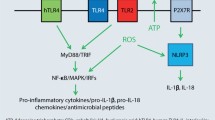Summary
Allergic contact dermatitis (ACD) is caused by chemical-reactive T cells. A prerequisite for their activation is the induction of skin inflammation by contact allergens. This requires the activation of signaling pathways of the innate immune system which are also activated in anti-infectious immune responses. The mechanistic basis of the essential innate inflammatory response to chemical allergens and its implications for pathogenesis, therapy, and immunotoxicology will be discussed in this minireview.



Similar content being viewed by others
Abbreviations
- ACD:
-
Allergic contact dermatitis
- CHS:
-
Contact hypersensitivity
- CpG-ODN:
-
CpG-oligodeoxynucleotides
- DAMP:
-
Damage-associated molecular pattern
- DC:
-
Dendritic cell
- Teff:
-
Effector T cells
- hTLR4:
-
Human TLR4
- HA:
-
Hyaluronic acid
- HAdase:
-
Hyaluronidase
- IL:
-
Interleukin
- IRF:
-
Interferon regulatory transcription factor
- LPS:
-
Lipopolysaccharide
- MHC:
-
Major histocompatibility complex
- MAPK:
-
Mitogen-activated protein kinase
- MI:
-
Methylisothiazolinone
- MyD88:
-
Myeloid differentiation factor 88
- NF-κB:
-
Nuclear factor-κB
- NLRP3:
-
Nod-like receptor protein 3
- Oxa:
-
Oxazolone
- PAMP:
-
Pathogen-associated molecular pattern
- PRR:
-
Pattern recognition receptor
- PMN:
-
Polymorphonuclear neutrophils
- ROS:
-
Reactive oxygen species
- STAT4:
-
Signal transducer and activator of transcription 4
- TLR:
-
Toll-like receptor
- TRIF:
-
TIR domain-containing adapter inducing IFN-β
- TNCB:
-
2,4,6-trinitrochlorobenzene
Literatur
Peiser M, Tralau T, Heidler J, Api AM, Arts JH, Basketter DA et al. Allergic contact dermatitis: epidemiology, molecular mechanisms, in vitro methods and regulatory aspects. Current knowledge assembled at an international workshop at BfR, Germany. Cell Mol Life Sci 2012;69:763–81
Schwensen JF, White IR, Thyssen JP, Menne T, Johansen JD. Failures in risk assessment and risk management for cosmetic preservatives in Europe and the impact on public health. Contact Dermatitis 2015;73:133–141
Puangpet P, Chawarung A, McFadden JP. Methylchloroisothiazolinone/Methylisothiazolinone and methylisothiazolinone allergy. Dermatitis 2015;26:99–102
Mahler V, Geier J, Schnuch A. Current trends in patch testing — new data from the German Contact Dermatitis Research Group (DKG) and the Information Network of Departments of Dermatology (IVDK). J Dtsch Dermatol Ges 2014;12:583–92
Martin SF, Esser PR, Schmucker S, Dietz L, Naisbitt DJ, Park BK et al. T-cell recognition of chemicals, protein allergens and drugs: towards the development of in vitro assays. Cell Mol Life Sci 2010;67:4171–84
Martin SF. Allergic contact dermatitis: it „smells“ like an infection. Allergo J 2011;20:81–6
Raghavan B, Martin SF, Esser PR, Goebeler M, Schmidt M. Metal allergens nickel and cobalt facilitate TLR4 homodimerization independently of MD2. EMBO Rep 2012;13:1109–15
Schmidt M, Raghavan B, Muller V, Vogl T, Fejer G, Tchaptchet S et al. Crucial role for human Toll-like receptor 4 in the development of contact allergy to nickel. Nat Immunol 2010;11:814–9
Kinbara M, Sato N, Kuroishi T, Takano-Yamamoto T, Sugawara S, Endo Y. Allergy-inducing nickel concentration is lowered by lipopolysaccharide at both the sensitization and elicitation steps in a murine model. Br J Dermatol 2011;164:356–62
Martin SF, Dudda JC, Bachtanian E, Lembo A, Liller S, Durr C et al. Toll-like receptor and IL-12 signaling control susceptibility to contact hypersensitivity. J Exp Med 2008;205:2151–62
Esser PR, Wolfle U, Durr C, von Loewenich FD, Schempp CM, Freudenberg MA et al. Contact sensitizers induce skin inflammation via ROS production and hyaluronic acid degradation. PLoS One 2012;7:e41340
Weber FC, Nemeth T, Csepregi JZ, Dudeck A, Roers A, Ozsvari B et al. Neutrophils are required for both the sensitization and elicitation phase of contact hypersensitivity. J Exp Med 2015;212:15–22
Li X, Zhong F. Nickel induces interleukin-1beta secretion via the NLRP3-ASC-caspase-1 pathway. Inflammation 2014;37:457–66
Dahlin DC, Miwa GT, Lu AY, Nelson SD. N-acetyl-p-benzoquinone imine: a cytochrome P-450-mediated oxidation product of acetaminophen. Proc Natl Acad Sci U S A 1984;81:1327–31
Martin SF. New concepts in cutaneous allergy. Contact Dermatitis 2015;72:2–10
Yasukawa S, Miyazaki Y, Yoshii C, Nakaya M, Ozaki N, Toda S et al. An ITAM-Syk-CARD9 signalling axis triggers contact hypersensitivity by stimulating IL-1 production in dendritic cells. Nat Commun 2014;5:3755
Kaplan DH, Igyarto BZ, Gaspari AA. Early immune events in the induction of allergic contact dermatitis. Nat Rev Immunol 2012;12:114–24
Dudeck A, Dudeck J, Scholten J, Petzold A, Surianarayanan S, Kohler A et al. Mast Cells Are Key Promoters of Contact Allergy that Mediate the Adjuvant Effects of Haptens. Immunity 2011;34:973–84
Martin SF. Adaptation in the innate immune system and heterologous innate immunity. Cell Mol Life Sci 2014;71:4115–30
Pedersen LK, Johansen JD, Held E, Agner T. Augmentation of skin response by exposure to a combination of allergens and irritants — a review. Contact Dermatitis 2004;50:265–73
Bonefeld CM, Nielsen MM, Rubin IM, Vennegaard MT, Dabelsteen S, Gimenez-Arnau E, et al. Enhanced sensitization and elicitation responses caused by mixtures of common fragrance allergens. Contact Dermatitis 2011;65:336–42
Johansson H, Albrekt AS, Borrebaeck CA, Lindstedt M. The GARD assay for assessment of chemical skin sensitizers. Toxicol In Vitro 2013;27:1163–9
Albrekt AS, Johansson H, Borje A, Borrebaeck C, Lindstedt M. Skin sensitizers differentially regulate signaling pathways in MUTZ-3 cells in relation to their individual potency. BMC Pharmacol Toxicol 2014;15:5
Dhingra N, Shemer A, Correa da Rosa J, Rozenblit M, Fuentes-Duculan J, Gittler JK et al. Molecular profiling of contact dermatitis skin identifies allergen-dependent differences in immune response. J Allergy Clin Immunol 2014;134:362–72
Quaranta M, Knapp B, Garzorz N, Mattii M, Pullabhatla V, Pennino D et al. Intraindividual genome expression analysis reveals a specific molecular signature of psoriasis and eczema. Sci Transl Med 2014;6:244ra90
Author information
Authors and Affiliations
Corresponding author
Additional information
Conflicts of interest
The author states that there are no conflicts of interest.
Cite this as
Martin SF. Novel concepts of immune responses to chemicals in allergic contact dermatitis. Allergo J Int 2016; 25: 1–5 DOI: 10.1007/s40629-016-0090-8
Rights and permissions
About this article
Cite this article
Martin, S.F. Novel concepts of immune responses to chemicals in allergic contact dermatitis. Allergo J 25, 17–21 (2016). https://doi.org/10.1007/s15007-016-1014-0
Received:
Accepted:
Published:
Issue Date:
DOI: https://doi.org/10.1007/s15007-016-1014-0




